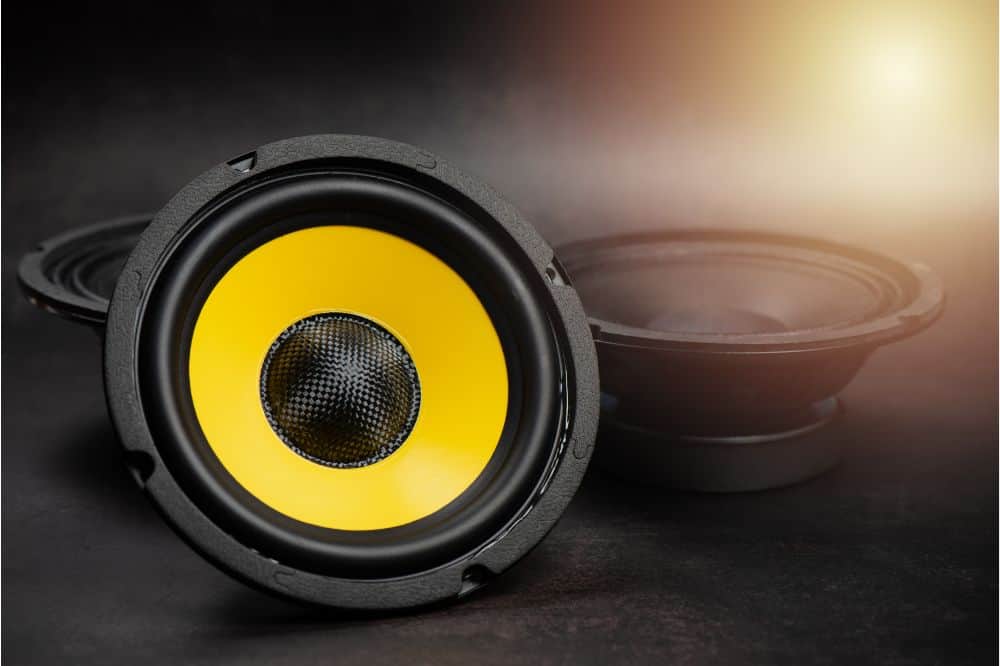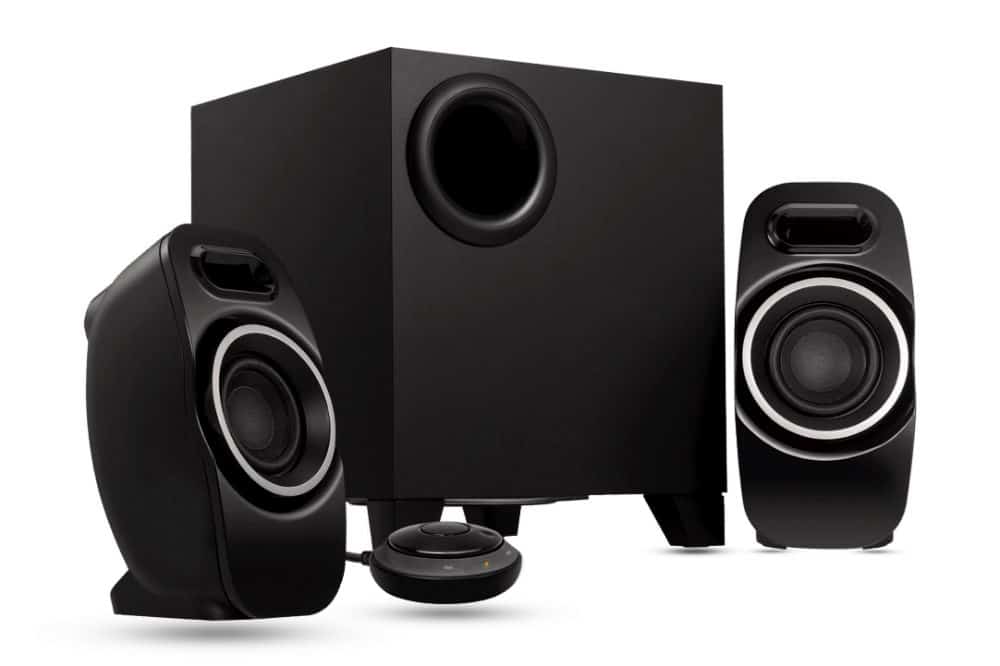After several years of setting up audio equipment for your workplace or entertainment center, you might have collected an inventory of different sound equipment. However, you’ve become used to purely passive configurations or easy-to-install powered models.
Suppose you have different sets of speakers in your inventory. Is a stable and functional connection possible between these components?
If you enjoy low-frequency sounds, you can take advantage of learning how to connect a powered subwoofer to passive speakers. We’ll explain several techniques and give a rundown of the essentials.
Before we do, let’s see how these speakers differ.
What Is a Powered Subwoofer?
In essence, any powered speaker has a built-in power amplifier and may or may not use an active crossover network for sound filtering.
Powered subwoofers can be passive speakers with an internal amplifier to power the device. The only difference between active speakers and a powered passive subwoofer is that the signal crossover occurs before amplification for the latter.
A subwoofer, whether powered or unpowered, is a type of speaker that can deliver low-frequency speaker outputs in the 20 to 200Hz range.
However, they cannot deliver high-frequency sounds. As such, it is always better to pair a subwoofer with a different set of midrange and high-frequency speakers.
What Are Passive Speakers?
On the other hand, a passive speaker is any speaker that requires an external amplifier. It cannot produce sounds without power from the amplifier.
All unpowered speakers are passive models, and they require external power sources.
A passive speaker can represent almost any main speaker, reproducing a more comprehensive range of frequencies, from around 100Hz up to 20,000Hz. These sounds include dialogues, lyrical music, high-pitched sounds, and all other high-frequency outputs.
Passive speakers offer the most customization features in any sound system arrangement. You can start with small setups and gradually move to a more diverse system comprised of both passive and active components.
Essentially, you can build different kinds of systems with passive speakers, but you might want to add more components to improve the system.
Is It Possible to Connect Passive Speakers to a Powered Subwoofer?
While passive speakers can reproduce the most common sounds, you won’t be able to get the low-frequency boom-booms from them. For this reason, the most common item you would think to add is a subwoofer. Basically, it’s just adding extra bass effects to your audio outputs.
Here’s the real question—can you connect passive speakers to a powered subwoofer?
The short answer is yes. However, you should know some critical considerations before we teach you how to connect a powered subwoofer to passive speakers.
Basic Considerations
First, note that a powered subwoofer is a self-powering device – it cannot provide power for other external components. Manufacturers design built-in amplifiers in powered speakers to supply power only for the built-in drivers. For this reason, an external amplifier is still necessary for the passive speakers you wish to pair with your powered sub.
Secondly, not all passive speakers have the features for connecting to a powered subwoofer. Older models, in particular, have fewer ports to make the connection possible.
Finally, amplifiers vary from brand to brand and from model to model. That said, connections will also depend on the features of your amplifier.

Types of Ports
You can check the ports on your amplifier to determine whether you can connect your subwoofer to your passive speakers.
You should know that audio components will have input and output ports of different types. Input ports will typically have “IN” written next to them, whereas output ports will have the “OUT” label nearby.
Also, the following list shows the most common types of audio component connector ports and cables required for a powered subwoofer and passive mains connection:
Tip-Ring-Sleeve (TRS)
TRS is a type of phone audio connection that comes in 1/4 or 1/8-inch diameter jacks and plugs. They have been around since the late 1800s, when the first switchboards were built.
External Line Return (XLR)
You can identify an XLR connector by its circular appearance having three to seven pins. However, audio XLR connectors only have three pins: one for negative polarity, another for positive polarity, and the third for cable shielding.
SpeakOn Connector Cables
SpeakOn cables are the latest connectors available for connecting loudspeakers to amplifiers. They are more reliable for conducting higher levels of electrical current.
Since people usually make mistakes when making connections using XLRs for decades, SpeakOn cables are the better replacement.
Low-Frequency Effects (LFE)
Modern amplifiers have an LFE channel. This channel is responsible for reproducing a dedicated bass-only sound signal normally sent to a subwoofer. The signal is a low-frequency sound output, usually in the 3-120Hz range.
Radio Corporation of America (RCA)
Also known as the phono, an RCA is an electrical connector commonly used to transmit video and audio signals. It is a type of coaxial cable that has been around since the 1930s.
The female and male components of an RCA connection are respectively called the RCA jack and RCA plug.
How to Connect a Powered Subwoofer to Passive Speakers
Now that you have a rough idea of what components you should have and what features they should carry, you can start making the connections.
The following are the most dependable and tested procedures for connecting a powered subwoofer to two passive speakers. Embedded in the procedures are varying methods for different connection types.
Remember, not all audio components are the same, so carefully choose the best method for your devices.
Step 1: Connect the source to a preamp or mixer.
Like in any complicated setup, you will probably use a mixer to diversify several audio inputs and create unique sound outputs. Nevertheless, a simple preamp will do if you only want to bring a weak signal to a line-level signal.
Step 2: Connect the preamp or mixer to the amplifier.
Connecting the preamp or mixer to the amplifier typically requires a TRS to XLR cable. However, you should check your components for the proper cables.
Step 3: Connect the passive speakers to the amplifier.
The next step is to connect the passive speakers to the amplifier. Many modern passive loudspeakers have replaced their ports with SpeakOn connectors. These connectors are more reliable when it comes to better audio quality.
Connect one end of the SpeakOn cable to your amplifier’s SpeakOn Out port and the other to your main speaker’s SpeakOn In port.
Step 4: Connect the subwoofer.
At this point, you can connect your subwoofer to your mixer or your amplifier, depending on which component has a usable port.
Suppose your mixer does not have an extra port available. You will have to route the audio signals to your subwoofer through your amplifier.
Here are a few methods you can try:
Method 1: TRS to XLR
Modern amplifiers have a LINK/OUT port, which is basically a parallel output port that delivers the same output signals to another speaker. In this case, our purpose is to connect to a powered subwoofer.
Most LINK/OUT ports require a TRS Out connection, while subwoofers typically use an XLR In connection.
If you follow Step 3 and Method 1 of Step 4, your amplifier should send power wattage to your passive speakers. Simultaneously, it should also send audio signals to your powered sub.
Adjust the volumes on the passive speakers through the controllers on your amplifier, and change the bass levels on the subwoofer controls.
Method 2: LFE Port
If your amplifier has an LFE Port, it will be clearly labeled “LFE,” “SUB OUT,” or “SUBWOOFER.” This port typically uses a single RCA-to-RCA connection, so get your RCA cable ready.
Connect one end of the RCA cable to your amplifier’s SUB OUT port and the other to the subwoofer’s LINE IN or LFE IN port.
Method 3: Stereo RCA
Suppose your components do not have the ports mentioned in methods 1 and 2. Check whether your amplifier has RCA Out ports and your subwoofer has RCA In ports.
If you have all the RCA ports on both components, you can use them to transmit stereo signals from the amp to the sub.
This connection typically uses a Y-connector for the left and right stations. Connect the end with the single RCA plug to your amplifier’s RCA Out port. Next, connect the double-RCA end to the subwoofer’s L (left) and R (right) In ports.
In some cases where the sub’s In ports are spring-type or banana clips, you might need some cable adapters.
Method 4: XLR Connections
If both your speakers and subwoofer support XLR connections, using XLR cables may be the best solution. However, such connections are only available in newer speaker models.
If you’re lucky enough to have such components, we suggest you stick to this method as it is even more reliable in delivering excellent sound quality.
Choose the Best Method
These methods are the best to follow when connecting a powered subwoofer to a pair of passive speakers. Check your components carefully to determine which connectors you can exploit.
In addition, try to understand the difference between active and passive speakers. Doing so makes the entire process a lot simpler and more manageable.
If you know a thing or two about active to passive connections, you’re well on your way to attaining a high-quality sound experience.

